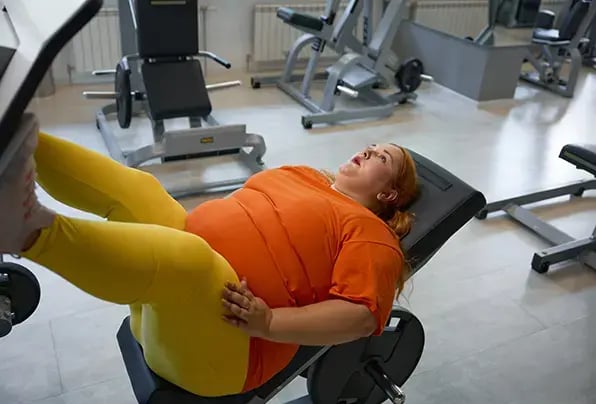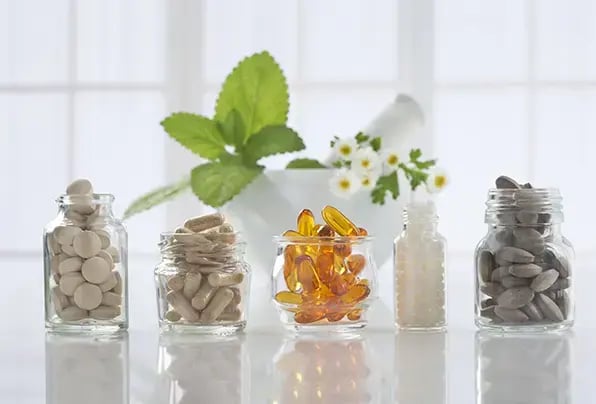Treating Lipedema: Strategies for Managing Your Condition
Tactics for Coping with Your Condition
To manage lipedema, patients often use a variety of approaches. These can include:
1. Healthy Eating: Eating a balanced diet can help reduce inflammation and ease symptoms.
2. Exercise: Activities like walking, swimming, or yoga can improve mobility and support the lymphatic system.
3. Compression: Wearing compression garments can help reduce swelling and discomfort.
4. Therapy: Physical therapy sessions tailored to the individual's needs can provide pain relief and improve quality of life.
By combining these treatments, patients can better manage their condition and improve their overall well-being.

Conservative Treatments for Lipedema
When exploring treatment options for lipedema, it's important to consider conservative approaches first. These treatments are non-invasive and aim to alleviate symptoms and slow down the progression of the condition. They encompass various strategies, including lifestyle modifications, mechanical interventions, and therapy.
Lifestyle Modifications and Mechanical Interventions
One aspect of conservative treatment involves making lifestyle changes, such as adopting a healthier diet and incorporating regular exercise into daily routines. These modifications can help manage weight and improve overall health, which may contribute to symptom relief in individuals with lipedema.
Mechanical interventions, such as manual lymphatic drainage (MLD) and the use of compression garments or pumps, are also integral components of conservative treatment. These techniques help reduce swelling and discomfort associated with lipedema by promoting lymphatic drainage and improving circulation in affected areas.

Therapeutic Approaches
Physical therapy has emerged as a promising therapeutic approach for managing lipedema symptoms. Studies have shown that tailored exercise programs and manual therapy techniques administered by certified professionals can effectively alleviate pain and enhance mobility in individuals with early-stage lipedema.
Therapists specializing in treating lipedema, such as Certified Lymphedema Therapists (CLTs), play a crucial role in guiding patients through these therapeutic interventions. Their expertise in designing personalized treatment plans and providing ongoing support can significantly benefit individuals coping with lipedema.
Invasive Treatments: Considerations and Implications
While conservative treatments form the foundation of lipedema management, invasive or surgical interventions may be considered in cases where symptoms are severe or unresponsive to non-invasive approaches. These procedures, such as liposuction or lymph node transplants, target underlying fat accumulation or lymphatic dysfunction associated with lipedema.
However, it's essential to carefully evaluate the risks and benefits of invasive treatments and consult with healthcare professionals before proceeding. Invasive procedures may not offer permanent solutions and may require ongoing maintenance to sustain results. Additionally, many insurance plans require patients to attempt conservative treatments before covering invasive procedures, emphasizing the importance of exploring non-invasive options first.
Our mission is to create a world where every investment in modern beauty is Worth It.
Let's keep in touch
Get updates of the treatments you are interested
The Role of Therapy in Lipedema Management
Therapy, particularly physical therapy, plays a crucial role in managing lipedema symptoms and improving overall quality of life. A proof-of-principle study conducted in 2022 demonstrated the effectiveness of physical therapy in reducing pain and inflammation in individuals with early-stage lipedema.
By integrating conservative treatments, therapeutic interventions, and surgical options as needed, individuals with lipedema can develop comprehensive management strategies tailored to their unique needs and circumstances. Collaboration with healthcare providers and adherence to personalized treatment plans are essential for optimizing outcomes and enhancing the quality of life for those living with lipedema.
Nutrition Tips for Lipedema
When it comes to nutrition for managing lipedema, there's still a lot to learn. Different diets have been tried, like paleo, keto, and low carb high fat (LCHF), but there's no one-size-fits-all solution. Since lipedema tissue doesn't respond well to cutting calories, the focus is often on reducing overall inflammation and easing symptoms through diet changes.
For those exploring new diets, it's essential to pay attention to how different foods affect symptoms. Keeping track of what worsens or improves symptoms can help tailor the diet to individual needs.

Exercise Recommendations
Exercise is crucial for managing lipedema. Recommended activities include walking, swimming, Pilates, biking, and yoga. These exercises help get the lymphatic system moving, protect joints if you're hypermobile, and build strength to manage weight.
Certified Lymphedema Therapists (CLTs) can design personalized exercise programs to support individuals with lipedema.
By focusing on nutrition and exercise tailored to their needs, individuals with lipedema can take proactive steps to improve their quality of life and manage symptoms effectively.
Supplements
Some people with lipedema might lack certain vitamins or minerals, which could mean they need to take supplements. But it's not clear-cut, and research hasn't settled on a definite answer yet. If you're considering supplements, it's best to talk to a doctor first. They can do tests to see if you need them and keep an eye on how you're using them.
Remember, supplements aren't checked by the FDA, so we don't always know what side effects they might have. Plus, most diuretics don't help reduce the swelling from lipedema.

Compression
But not all compression gear is the same. It comes in different types, sizes, and strengths, and these things can affect how well it works to reduce swelling and pain. To find the right compression gear, it's a good idea to work with a therapist or a specialist who knows about fitting compression gear.
Surgical Treatments
The surgeries often considered include: Liposuction, vein surgery, knee or hip replacements, removing fat nodules, bariatric surgery for abdominal obesity*, and debulking/lifts/resections.
Before surgery, it's crucial to plan carefully, with a routine tailored to each patient. Surgeons might recommend healthy habits like eating well and exercising before the operation. They also try hard to avoid harming the lymphatic and blood vessels during surgery.
Some insurance plans need patients to try other treatments first before covering surgery. Each plan is different, so it's important to check with your provider.
Notes on Liposuction
Patients need to understand that the results of liposuction might vary. Surgeons often focus on reducing pain, stopping the condition from getting worse, and improving movement.
While a few surgeons claim to remove all lipedema fat and "cure" the patient, it's hard to know if that's true. There's no definite way to say if all lipedema fat is gone or if the main problem was fixed.

Other Surgical Considerations
Surgery can affect mental health too, so it's important to have realistic expectations about recovery and goals.
Following pre-op and post-op instructions is vital, and it's wise to start healthy habits before surgery, like eating well and using compression garments.
The lymphatic system and its issues can affect how anesthesia works during surgery.
Before choosing surgery, it's essential to research carefully. Social media can help connect with other patients who've had similar experiences.
While bariatric surgery might not directly affect lipedema tissue, it can help reduce non-lipedema fat and obesity. Patients should keep this in mind when deciding on treatments.
Tactics for Coping with Your Condition
To manage lipedema, patients often use a variety of approaches. These can include:
1. Healthy Eating: Eating a balanced diet can help reduce inflammation and ease symptoms.
2. Exercise: Activities like walking, swimming, or yoga can improve mobility and support the lymphatic system.
3. Compression: Wearing compression garments can help reduce swelling and discomfort.
4. Therapy: Physical therapy sessions tailored to the individual's needs can provide pain relief and improve quality of life.
By combining these treatments, patients can better manage their condition and improve their overall well-being.

Conservative Treatments for Lipedema
When exploring treatment options for lipedema, it's important to consider conservative approaches first. These treatments are non-invasive and aim to alleviate symptoms and slow down the progression of the condition. They encompass various strategies, including lifestyle modifications, mechanical interventions, and therapy.
Lifestyle Modifications and Mechanical Interventions
One aspect of conservative treatment involves making lifestyle changes, such as adopting a healthier diet and incorporating regular exercise into daily routines. These modifications can help manage weight and improve overall health, which may contribute to symptom relief in individuals with lipedema.
Mechanical interventions, such as manual lymphatic drainage (MLD) and the use of compression garments or pumps, are also integral components of conservative treatment. These techniques help reduce swelling and discomfort associated with lipedema by promoting lymphatic drainage and improving circulation in affected areas.

Therapeutic Approaches
Physical therapy has emerged as a promising therapeutic approach for managing lipedema symptoms. Studies have shown that tailored exercise programs and manual therapy techniques administered by certified professionals can effectively alleviate pain and enhance mobility in individuals with early-stage lipedema.
Therapists specializing in treating lipedema, such as Certified Lymphedema Therapists (CLTs), play a crucial role in guiding patients through these therapeutic interventions. Their expertise in designing personalized treatment plans and providing ongoing support can significantly benefit individuals coping with lipedema.
Invasive Treatments: Considerations and Implications
While conservative treatments form the foundation of lipedema management, invasive or surgical interventions may be considered in cases where symptoms are severe or unresponsive to non-invasive approaches. These procedures, such as liposuction or lymph node transplants, target underlying fat accumulation or lymphatic dysfunction associated with lipedema.
However, it's essential to carefully evaluate the risks and benefits of invasive treatments and consult with healthcare professionals before proceeding. Invasive procedures may not offer permanent solutions and may require ongoing maintenance to sustain results. Additionally, many insurance plans require patients to attempt conservative treatments before covering invasive procedures, emphasizing the importance of exploring non-invasive options first.
Our mission is to create a world where every investment in modern beauty is Worth It.
Let's keep in touch
Get updates of the treatments you are interested
The Role of Therapy in Lipedema Management
Therapy, particularly physical therapy, plays a crucial role in managing lipedema symptoms and improving overall quality of life. A proof-of-principle study conducted in 2022 demonstrated the effectiveness of physical therapy in reducing pain and inflammation in individuals with early-stage lipedema.
By integrating conservative treatments, therapeutic interventions, and surgical options as needed, individuals with lipedema can develop comprehensive management strategies tailored to their unique needs and circumstances. Collaboration with healthcare providers and adherence to personalized treatment plans are essential for optimizing outcomes and enhancing the quality of life for those living with lipedema.
Nutrition Tips for Lipedema
When it comes to nutrition for managing lipedema, there's still a lot to learn. Different diets have been tried, like paleo, keto, and low carb high fat (LCHF), but there's no one-size-fits-all solution. Since lipedema tissue doesn't respond well to cutting calories, the focus is often on reducing overall inflammation and easing symptoms through diet changes.
For those exploring new diets, it's essential to pay attention to how different foods affect symptoms. Keeping track of what worsens or improves symptoms can help tailor the diet to individual needs.

Exercise Recommendations
Exercise is crucial for managing lipedema. Recommended activities include walking, swimming, Pilates, biking, and yoga. These exercises help get the lymphatic system moving, protect joints if you're hypermobile, and build strength to manage weight.
Certified Lymphedema Therapists (CLTs) can design personalized exercise programs to support individuals with lipedema.
By focusing on nutrition and exercise tailored to their needs, individuals with lipedema can take proactive steps to improve their quality of life and manage symptoms effectively.
Supplements
Some people with lipedema might lack certain vitamins or minerals, which could mean they need to take supplements. But it's not clear-cut, and research hasn't settled on a definite answer yet. If you're considering supplements, it's best to talk to a doctor first. They can do tests to see if you need them and keep an eye on how you're using them.
Remember, supplements aren't checked by the FDA, so we don't always know what side effects they might have. Plus, most diuretics don't help reduce the swelling from lipedema.

Compression
But not all compression gear is the same. It comes in different types, sizes, and strengths, and these things can affect how well it works to reduce swelling and pain. To find the right compression gear, it's a good idea to work with a therapist or a specialist who knows about fitting compression gear.
Surgical Treatments
The surgeries often considered include: Liposuction, vein surgery, knee or hip replacements, removing fat nodules, bariatric surgery for abdominal obesity*, and debulking/lifts/resections.
Before surgery, it's crucial to plan carefully, with a routine tailored to each patient. Surgeons might recommend healthy habits like eating well and exercising before the operation. They also try hard to avoid harming the lymphatic and blood vessels during surgery.
Some insurance plans need patients to try other treatments first before covering surgery. Each plan is different, so it's important to check with your provider.
Notes on Liposuction
Patients need to understand that the results of liposuction might vary. Surgeons often focus on reducing pain, stopping the condition from getting worse, and improving movement.
While a few surgeons claim to remove all lipedema fat and "cure" the patient, it's hard to know if that's true. There's no definite way to say if all lipedema fat is gone or if the main problem was fixed.

Other Surgical Considerations
Surgery can affect mental health too, so it's important to have realistic expectations about recovery and goals.
Following pre-op and post-op instructions is vital, and it's wise to start healthy habits before surgery, like eating well and using compression garments.
The lymphatic system and its issues can affect how anesthesia works during surgery.
Before choosing surgery, it's essential to research carefully. Social media can help connect with other patients who've had similar experiences.
While bariatric surgery might not directly affect lipedema tissue, it can help reduce non-lipedema fat and obesity. Patients should keep this in mind when deciding on treatments.





.webp?width=738&height=510&name=liposuction%20(1).webp)

